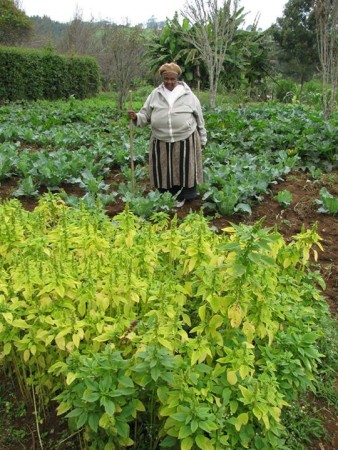A short Smithsonian.com piece by Barry Estabrook does a really outstanding job of describing — no, explaining — the conservation and use of crop wild relatives to a lay audience. It’s all there. The value to crop breeders of genes from wild relatives. The history of germplasm exploration, and how it has resulted in the establishment of large collections. The need for, and urgency of, further collecting. The use of information from genebanks to guide future exploration. The challenges that such work faces, including on the policy side. And the euphoria that it can generate when you do overcome those challenges. All in a couple of pages, using a single wild species as an example. And if, once you finish reading the story, you want to know more about what Estabrook was chasing in Peru, it’s (probably) this.
Nibbles: Oz vineyard apocalypse, California vineyards redux, Ethiopian genebank, Maya collapse revisionism, SunBlack tomato, Nutritious staples, Citrus endowment, Sheep pix
- In Australia, they’re ripping up vineyards.
- Whereas in California, they’re going to breed 10,000 new grape varieties and make a new wine. Go figure.
- Interview with the director of the Ethiopian national genebank, Dr Gemedo Dalle.
- Deforestation et al. not responsible for Maya collapse after all. Jared Diamond unavailable for comment.
- Black tomato a hit in Italy. Looks crap on pizza though.
- The case for biofortification.
- University of Florida sets up endowment to protect its research groves in face of citrus greening.
- Googlesheepview. Nuff said.
Digital filmmakers (and others) tackle African leafy greens
I came across this cool video about African indigenous vegetables via the Horticulture Innovation Lab newsletter. Made by a student at Rutgers University’s Center for Digital Filmmaking, it describes work led by Jim Simon of Rutgers and Steve Weller of Purdue University in Kenya and Zambia on growing and marketing plants like African nightshade (Solanum scabrum?), amaranth (Amaranthus spp), and spider plant (Cleome gynandra).
There’s another video on the website too. Well worth watching both, and indeed following the blog.
And if you want more video on African leafy greens, they feature in several episodes of Shamba Shapeup, Kenya’s version of Extreme Makeover: Farm Edition.
 Oh, and BTW: vote for me!!! I’m only about a thousand or so “likes” behind the leader. Ok, it’s a mere photo rather than a video, but still…
Oh, and BTW: vote for me!!! I’m only about a thousand or so “likes” behind the leader. Ok, it’s a mere photo rather than a video, but still…
Nibbles: Seeds app, Ruminant breeding, Minor crops, Forage grass, Cereals scholarships, Tasty sweetpotatoes
- Choose the right seeds. For Kenya.
- Cross the right goats. In Kenya.
- Eat the right underutilized crops. In Kenya.
- Grow the right Brachiaria. In Kenya.
- Pick the right people. From Kenya.
- Breed the right, i.e. tasty, sweetpotatoes. In Kenya. And elsewhere, admittedly.
Nibbles: Seed access, Funding genebanks, Vote for me dammit, Quality AND yield, Floating gardens, Chocography, Wine heritage double, Uzbeki bread
- African Seed Access Index comes out for Kenya, Uganda, South Africa, and Zimbabwe.
- New way to fund crop diversity conservation to be unveiled at FFD3 in Addis Ababa next week.
- “When you looked for ‘Ethiopia’ in a dictionary, it would also always mention ‘famine’. Now that time is over.”
- Vote for me!!!! I so want to win this damn Bioversity photo competition.
- Yes, you can have your long-grain rice and yield too!
- Everybody loves floating gardens.
- Mapping chocolate.
- “Why Is there Wine on the UNESCO World Heritage List?” Why the hell not?
- Lost grapes in Shangri-La. UNESCO beckons?
- Flatbreads rule.